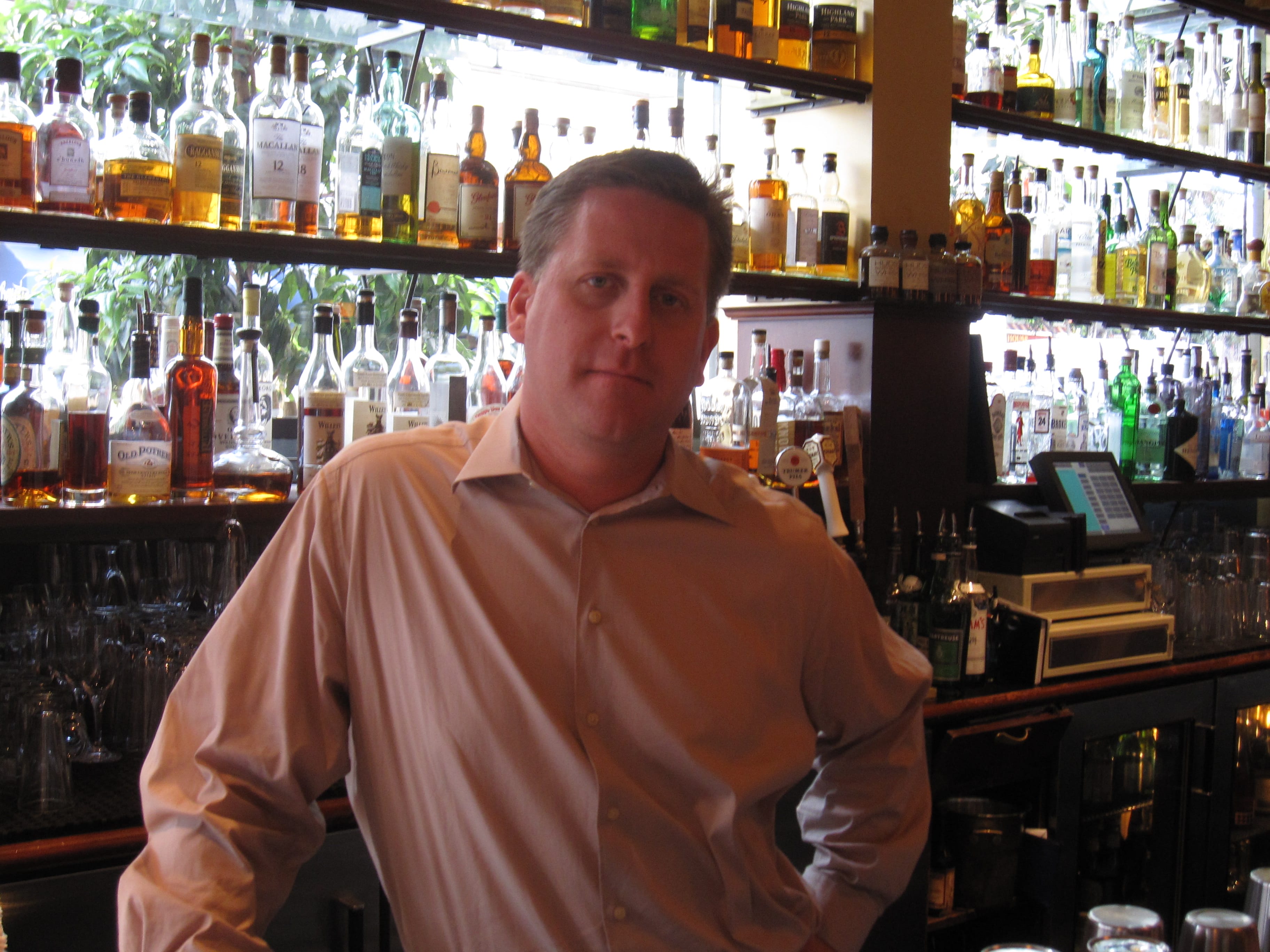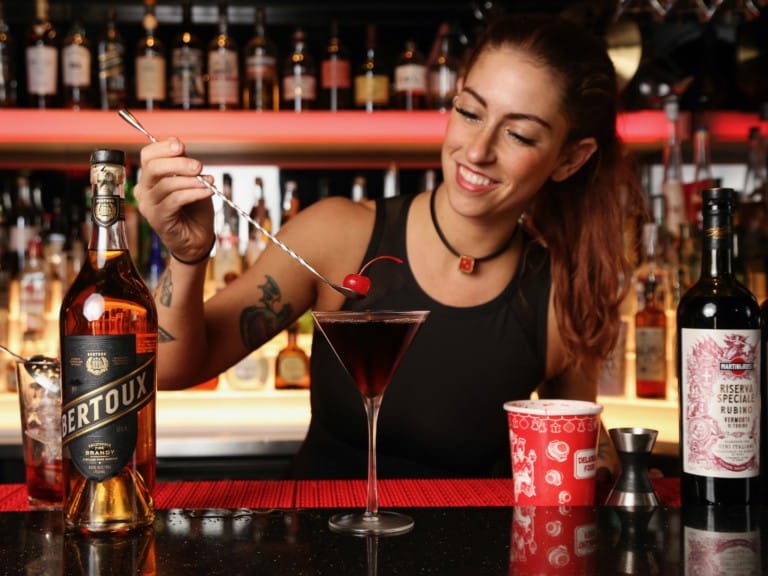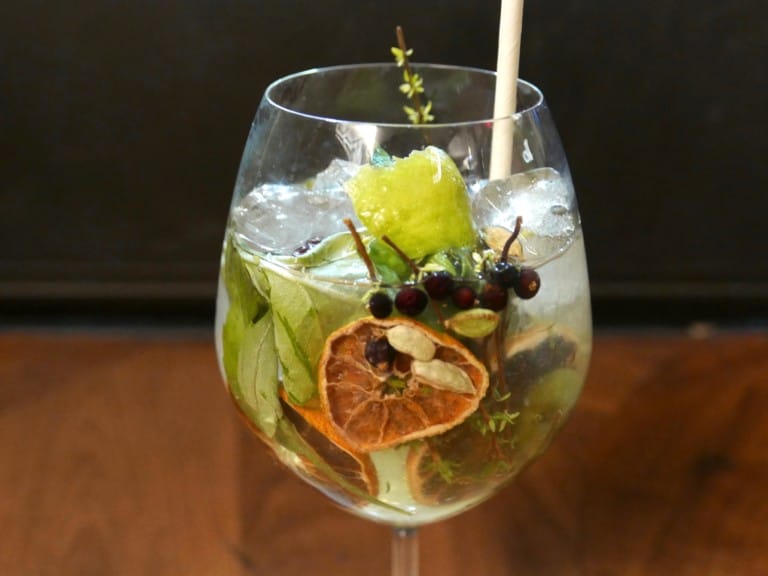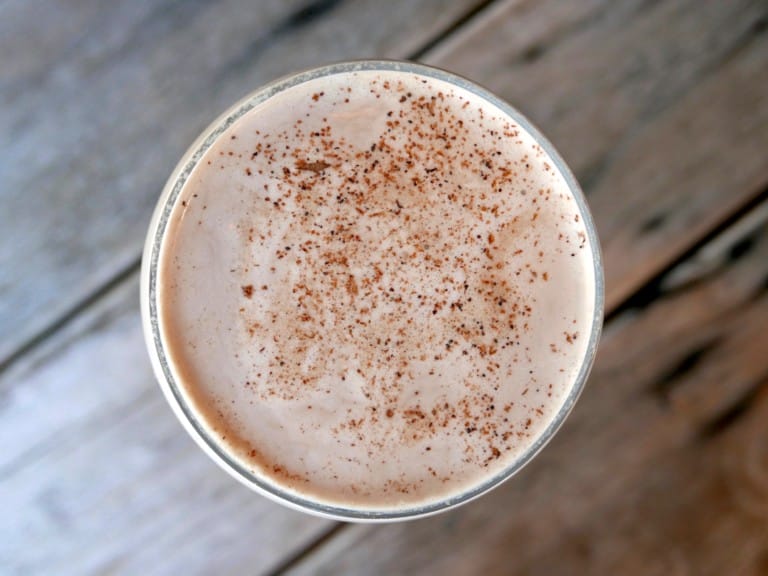Before Jeff Hollinger fell for cocktails, he was passionate about food. The Huntington Beach native attended the California Culinary Academy in San Francisco. At Gordon’s House of Fine Eats – Gordon Drysdale’s cutting-edge but bygone restaurant in SoMa – he decided to move from the kitchen to the bar. Hollinger scored a coveted bartending job at Absinthe, which set the standard for classic cocktails in San Francisco. He’s been at the Hayes Valley brasserie for the past seven years, rising to the rank of general manager but remaining committed to the bar program. He teamed with Rob Schwartz – the man who hired him at Absinthe – on a project called The Art of the Bar, a cocktail book that was published by Chronicle Books in 2006. Hollinger is now in his final weeks at Absinthe. He’s opening another bar called Comstock Saloon in North Beach, from the same parent company. Hollinger recently sat down at Absinthe to discuss his past, his approach and his future.
Would you consider yourself a bartender or mixologist?
My default, because I don’t bartender right now, a mixologist. I’ve always been a bartender at heart, and I always will be a bartender at heart, even though I know I won’t bartend continually for the rest of my life. I will always be interested in cocktail creation, cocktail development, the promotion and education about the history of the cocktail. I’ve gotten myself involved in cocktails in a lot of ways. I just had a meeting this afternoon to become involved in an organization called the Barbary Coast Conservancy. It’s an organization that promotes all things beverage related, but ultimately it stems from the promotion of San Francisco cocktail culture. We started putting on San Francisco Cocktail Week three years ago and it was designed to be a celebration of our cocktail culture and cocktail community. It’s evolved into this entity that educates the general public about spirits, coffee, water, everything that we do and love as bartenders and as people in this industry.
When’s the next San Francisco Cocktail Week?
September 20-27, 2010. It’s typically the second week of May, but we just decided to push it back. San Francisco in September is beautiful. It’s just off the hook. It’s really trying to tap into that. Doing cocktail week in May is a lot of fun, but the one thing we’ve run into is, what you have access to is citrus, strawberries and a few herbs. Not much else is around. You start to come into September, you have late season stone fruit, you still have tomatoes…There’s this wealth of produce you can pull from and the weather’s just absurdly beautiful in San Francisco.
How did you become so interested in cocktails?
My grandparents had a house in Glendale. My grandfather had a little stand-behind two seater bar. It’s where as kids we’d all play. We gathered there and made Shirley Temples and played bartender. It was just something fun to do. I like the nostalgia of that, playing with all the bar trinkets that he had. I just got into that idea. There was something romantic about it, so I started collecting glassware and started buying booze and books. It just became something; I was interested in food and drink anyway. It all just exploded from there.
What spirit or liqueur are you interested in at the moment? Anything in particular?
It depends. Mixing cocktails, I’ve been playing a lot with agave based spirits, tequila and mezcal. Mezcal’s a lot of fun to use in cocktails. It brings in that smoky element, but you still get that salty-savory thing. I use whiskey a lot. I’m always a fan of rye whiskey…The flip side is if I’m doing something with a culinary twist to it; I come from a food background. Before I got into the bar industry, I went to culinary school and I’ve always been interested in food, so I try to manipulate things in a different way. It’s more than just muddling and herbing a cocktail. It’s like taking a mushroom…
The candy cap you recently used in L.A.?
Yeah, taking a savory element, whether it’s a mushroom or a beet and infusing it in or making a liqueur out of it. It’s taking things like that and finding a way…if I see a dish the chefs created that looks interesting and has different nuances of flavor, I’ll try to make something that goes in a glass and make something that somebody’s going to want to drink.
Do you do any cocktail pairings?
Sometimes. It’s funny that I was in L.A. doing cocktail pairings. I’m not a huge fan of them. They’re interesting to do from a creative standpoint. I like that challenge of coming up with something. I love the idea of being able to work with a chef to be able to come up with ideas, bounce things off each other and come up with a dish. It’s a lot of fun. Personally, I think that high-proof alcohol gets in the way of food. When you think about a cocktail, it’s generally higher proof than wine. There’s bolder, more assertive flavors that are going to come through, typically in the form of acid. You’re talking about citrus or even using a gastrique. Even if you’re getting your acid through a vinegar, you’re still having a higher acid content than you would with a crisp white wine. It gets in the way of the food.
What’s a recent that you developed and what was your approach?
The two things that I did down in L.A., the Sideways in Reserve, the one that I paired with the short ribs, the idea for that came out wine. I talked with the chef [Walter Manzke] about what he was doing for his dish and started thinking, if I was having short ribs and foie and black pepper sauce, I started thinking about what wine would I like to drink with that. I’d like something that’s fairly bold and has some spice, a little bit of backbone, with a little bit of spice behind it. I started thinking of a Rhone varietal that’s going to work with that. I wouldn’t want to go with some big over-the-top tannic cab. I wanted something with some subtleties, but also some muscle behind it. So I started thinking, “What can I do for the cocktail?” Given that it was a meat course, I instinctively thought let’s go with whiskey. Then I was trying to bring in a savory element. I played around with candy cap cocktails in the past. I infused candy cap and rye together and liked the way it came out. I got the earthy notes I wanted with that, even though candy caps have a lot of cinnamon and a lot of caramel, there’s also a lot of earth that comes through from the nature of it being a mushroom. So I started thinking about that. I took rye and infused it with candy caps. I took a Languedoc wine, knowing that it would lose some of the subtleties of the wine, but I wanted to go with something with brighter, juicier flavors that had acid to it. I took that and infused it with black peppercorn and sherry vinegar and added a little sugar just to sweeten it up. I added a little Madeira, and the Madeira came in as a way to soften and bring everything together. It was also something that worked with the foie that was on the table. Madeira and foie go beautifully together. Kind of bring everything together was my approach. The last element of that was a rosemary spritz over the top. I essentially just took rosemary and infused it into a high-proof spirit and put that into an atomizer and sprayed it over the glass. That was really to give it a savory note. As soon as you put your nose into the glass, you would get that savory rosemary aroma. To me, it kind of spoke to what was going on the plate. The rosemary was gone and then you got into all the other layers of the cocktail.
The other one I did, The Smoke and Glass, mezcal, pear brandy, absinthe and a dash of orange bitters, that one I got behind the bar and made for people. That was something that I was working with that agave smoke and found a way to round it up. I love agave and absinthe together. They’re best friends.
Have you served any of those cocktails here?
I don’t have enough to be able to infuse enough bottles and be able to run it sustainably behind the bar here. Those mushrooms actually came from one of my servers, who’s a mushroom hunter. Unless he can get me tons and tons of them, they wouldn’t necessarily be a sustainable thing. Candy caps are ridiculously expensive when you start buying them by the pound, so it just doesn’t make sense to start doing them here. It would make sense to start doing them at Comstock. It wouldn’t be something that would be on the cocktail list, but it would be something that would be, “Oh by the way, I can do this for you.”
Where do you like to go drink in San Francisco?
I’ll preface this with – I spend 95% of my time here. It’s just the nature of the job…When I do, some of my favorite places in town, I love going over to Nopa. Neyah White to me has one of the coolest cocktail programs in town. The reason why is that he does that whole thing of trying to use a lot of different ingredients. He’s got a lot of different bitters, different shrubs he’s creating. If he’s going to create an original cocktail that’s going to go on his menu, he has one thing that he calls the “Nopa stamp.” It’s one ingredient that you can get anywhere else but at his bar. It’s special. It’s unique, without being too far out there, without trying to challenge people too much. I dig what he does. I dig the Alembic, which is a great whiskey bar without screaming, hey, check us out. For the longest time, they’ve made the best Sazerac in town. Heaven’s Dog just opened up this past year. Erik Atkins put together one of the coolest cocktail programs in that it’s simple, but without necessarily going and stealing all these recipes out of Charles Baker’s The Gentleman’s Companion book. He built a cocktail program around that book, around the philosophy of what Charles Baker put together, really, really cool stuff. Those are probably my favorite spots right now.
If you were going to suggest a simple cocktail for people to make at home, what would it be and what would it involve?
It kind of depends on what somebody likes to drink. If I were to suggest a simple cocktail, it’s starting to get wintry outside. It’s been raining all day, it’s Manhattan weather. It doesn’t get much simpler than that. It’s two parts rye whiskey, one part sweet vermouth, a dash of Angostura bitters and stir. It’s as simple as you can get. In the summertime, I’ve always been a big fan of margaritas. It goes back to my grandmother on my mom’s side, on Christmas Eve we’d go have margaritas, so I’ve always been a fan of that. You just go lime, tequila, Cointreau and triple sec, maybe a splash of agave nectar, depending on how sweet you want it, shake it and done. I’m a huge proponent of the idea that if you’re making cocktails at home, keep it as simple as you can. As much as I like coming up with different ingredients and playing chef back there, I do that because that’s what keeps me progressing and challenging myself. What I drink is the complete opposite of that. I drink simple cocktails. I drink Manhattans, Sazeracs and order shots and beer.
Would you say you have any cocktail mentors?
That’s a weird thing. I’m not sure if I do or not. Reza Esmaili, who has been at Conduit for awhile, was the first bartender who hired me in San Francisco and really gave me a shot at Gordon’s. I learned a lot from him. I’m not sure if I look to him as a mentor now because we operate a peer level, but I’ll always be grateful to him for the chance he gave me to learn from him. That’s always somebody that I look to and thought I wouldn’t be doing what I’m doing if it wasn’t for the opportunity. Rob Schwartz was the same way. When I came here, he was the guy who knew everything about spirits. I was able to pick his brain and be challenged by him, and then start to challenge him as well. As far as who I look to as mentors now, I honestly don’t know. I kind of pay attention to what’s going on around town and what people are doing, but I also kind of don’t. It doesn’t drive me, per se. What drives me is curiosity, for my own sake. To pick people’s brains, I don’t know that I have it. Johnny, the bar manager here, is probably the closest thing. We look to each other as peers and challenge each other. He’s coming up with new things, I’m coming up with new things, and we’re kind of bringing it to the table. It’s a collaborative thing, less of me being a mentor for him or him being a mentor for me. It’s more of a partnership thing.
If you could only drink one more cocktail, what would it be?
Honestly, probably a Rittenhouse 100 Manhattan. Rittenhouse 100, two parts, one part Punt E Mes and three dashes of Angostura bitters and three brandied cherries, and after about two sips, I’d probably pour a little Champagne into it and turn it into a Boothby.
What will distinguish Comstock Saloon from Absinthe?
A lot of it has to do with size and scale. Absinthe has a giant spirits program, a really, really big cocktail program. A lot of it has to do with the fact that we’ve got a big back bar. Absinthe was built on the idea of classics, on the idea of classics, but also tweaking things and doing originals. We’ve been in business for 11 years. There’s always been someone at the helm who’s gotten a lot of interesting cocktails. We got a backroll of all these different cocktails. It’s continued under my watch and under Johnny Raglin’s watch. He was bar manager up until this past weekend, who I’m opening the bar with. We’ve taken things in a lot of different directions. We’ve done things, taken the culinary approach to cocktails, we started working with making our own liqueurs, worked on some different house-made vermouths and things like that. Those things have been on kind of a small scale. At Comstock, it will be taking a lot of that, making liqueurs, making bitters, making vermouths, wherever we can, doing that stuff in-house. We’ll have a smaller spirits program, a smaller cocktail program, but be able to tailor things to the individual guest experience. Rather than have a cocktail list that is three or four pages long and 30 cocktails deep, we’ll have a list that’s somewhere between five and 10 cocktails, the majority of those are classics, but also be able to tailor a cocktail around what you want or what we’re experimenting with at the time.
What was Comstock Saloon previously?
It still is San Francisco Brewing Company. It’s been a bar essentially since 1907. The space was destroyed in the 1906 quake. It was rebuilt and originally was a bar called The Andromeda. After The Andromeda, it became the Albatross Saloon. It was a café during Prohibition. About 25 years ago, the gentleman who owns it now started up the second or third brewpub in the country. The San Francisco Brewing Company was around for 25 years, and we’re taking it back to what it was, back to a classic 20th Century cocktail saloon.

A parting shot of The Agenda: Knob Creek Bourbon, peach shrub, grapefruit juice and grapefruit bitters in a coupe









Blog Comments
Tweets that mention Food GPS » Blog Archive » Q&A with Absinthe manager Jeff Hollinger -- Topsy.com
November 17, 2009 at 7:29 PM
[…] This post was mentioned on Twitter by foodgps, PostRank – Food. PostRank – Food said: Q&A with Absinthe manager Jeff Hollinger http://bit.ly/FsLnC #postrank #food […]
Libertini
November 17, 2009 at 9:21 AM
Instead of Punte E Mes ….Carpano Antica —- and Amarena Fabbri cherries, for a Manhattan
Kouba
November 16, 2009 at 11:02 AM
Thank you! You often write very interesting articles. You improved my mood.